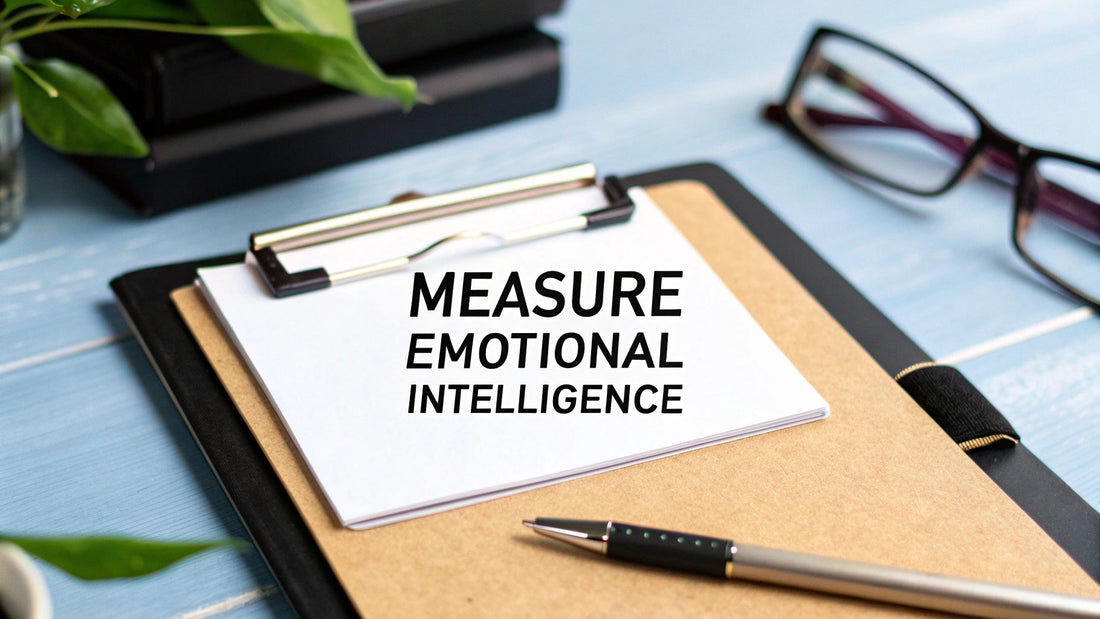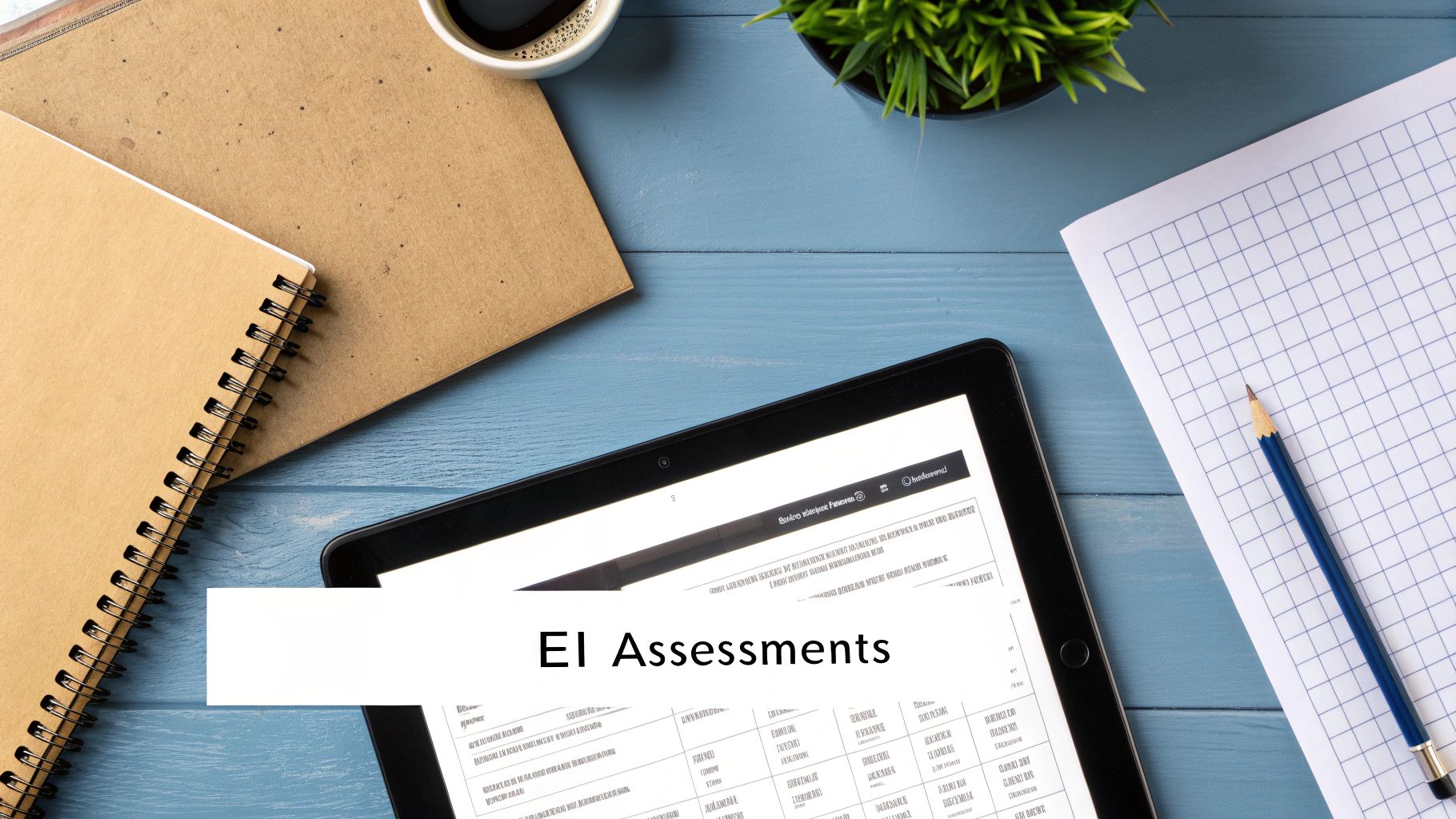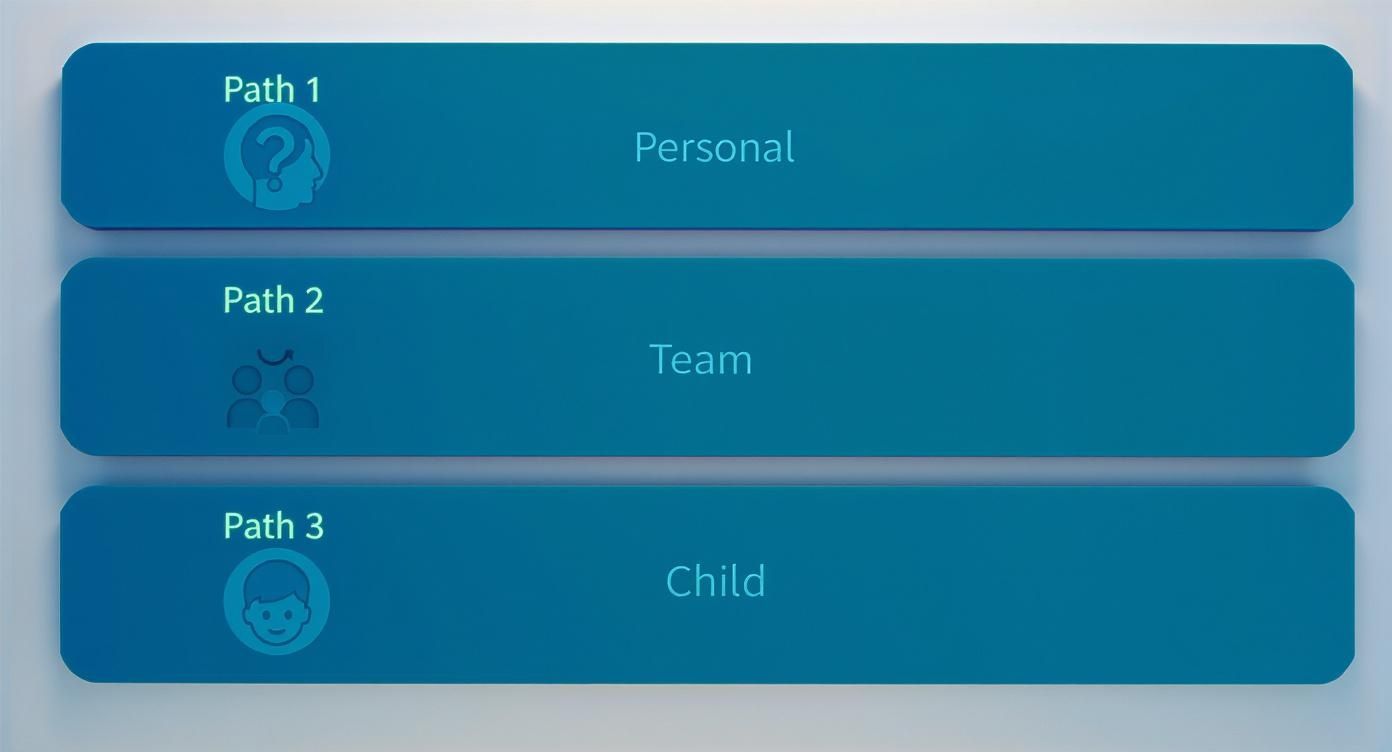
How to Measure Emotional Intelligence
Share
Before we can talk about measuring emotional intelligence, we need to get on the same page about what it actually is. Think of it as a set of practical skills for spotting, understanding, and managing our own emotions, while also being able to influence the emotions of those around us. It’s all about being tuned in to how you feel and act, and realising the ripple effect that has on others.
What Is Emotional Intelligence and Why It Matters

Emotional intelligence (EI) isn’t some fixed trait you’re born with; it’s a collection of skills you can build and adapt over time. It’s the secret sauce that separates a good manager from a great one, or what makes someone a truly supportive friend.
Imagine a crisis at work. A leader with high EI stays calm and thinks clearly, which helps reassure their team. A practical example would be a project manager whose team misses a major deadline. Instead of reacting with anger, they calmly call a meeting to understand what went wrong, listen to everyone's concerns, and collaboratively create a new plan. This builds trust rather than fear.
The Core Components of EI
When we look at how to measure emotional intelligence, we’re really breaking it down into its key parts. These skills are all interconnected and work together to shape how we navigate the world.
- Self-Awareness: This is the bedrock. It’s about being able to recognise your own emotions as they happen and understanding what’s causing them.
- Self-Regulation: Once you’re aware of an emotion, this is your ability to manage it. It’s that crucial pause before you react in anger or frustration.
- Empathy: This is all about understanding and sharing the feelings of other people. The key here is not to imagine how you would feel in their shoes, but to truly grasp how they feel.
- Social Skills: This is where everything comes together. It’s what allows you to build strong relationships, communicate clearly, and handle conflicts with a bit of grace.
Why EI Is Crucial for Mental Wellbeing
Having strong emotional intelligence is a massive advantage when it comes to navigating life’s challenges, especially for children and young people. Growing up today comes with a unique set of pressures, from academic performance to the non-stop buzz and comparison culture of social media, all of which can take a real toll on mental health.
Addressing mental health early is incredibly important. In the UK, one in six children aged 7 to 16 has a probable mental health problem, a figure that really underscores the need for better support and tools.
Developing EI gives young people the skills to build resilience and cope with these pressures. Learning to simply identify and manage feelings is a fundamental piece of the puzzle, a concept we explore in our guide to what is social emotional learning.
By getting to grips with their own emotional landscape, they become much better equipped to build healthy relationships and look after their own wellbeing. This ability to understand and manage emotions isn't just a childhood lesson; it's a skill that will serve them for the rest of their lives.
Comparing the Main Types of EI Assessments

When you decide you want to measure emotional intelligence, you'll quickly discover it’s not a one-size-fits-all situation. There are a few different ways to go about it, and each method offers a unique window into how we perceive and handle emotions. Getting to grips with these is the first real step to finding the right fit for you, your family, or your team.
In the UK, the most respected methods rely on psychometrically validated instruments. You’ll often hear names like the Mayer-Salovey-Caruso Emotional Intelligence Test (MSCEIT), the Bar-On Emotional Quotient Inventory (EQ-i), and the Trait Emotional Intelligence Questionnaire (TEIQue). Each of these is built on a different model of EI, which just goes to show there are varying expert opinions on what emotional intelligence truly is. If you're curious about the science, you can find out more about the research behind these EI models.
Understanding the Three Core Methods
Every type of assessment has its own strengths and is built for a specific purpose. Some are about digging into how you see yourself, while others are more like an exam, testing your emotional skills directly.
Self-Report Questionnaires: These are by far the most common. You’ll answer questions about your own behaviours, tendencies, and feelings, usually by rating statements like "I am good at understanding the way I feel." The key thing here is that this approach measures your perceived EI – your own view of your abilities.
Ability-Based Tests: This is a totally different ball game. Instead of just asking what you think you'd do, these tests present you with actual emotional problems to solve. It’s much less about your self-perception and far more about your genuine problem-solving skills when emotions are involved. Think of it like an IQ test, but for feelings.
Mixed-Model Assessments: Just as the name implies, this approach blends elements from the other two. It looks at a combination of personality traits, learned competencies, and emotional skills to give a more holistic view.
A good thing to remember is that no single test can ever tell the whole story. Self-report tests are brilliant for personal reflection and getting a conversation started, but an ability test might offer a more objective measure of someone's skills in the heat of the moment.
To make things a bit clearer, let's break down how these different assessment methods stack up against one another.
Comparison of EI Assessment Methods
| Assessment Type | How It Works | Best For | Pros | Cons |
|---|---|---|---|---|
| Self-Report | You rate yourself on a series of statements about emotional behaviours. | Personal development, quick insights, coaching. | Easy to administer, provides a great starting point for self-reflection. | Can be influenced by your mood, self-perception bias, or a desire to answer in a socially acceptable way. |
| Ability-Based | You solve problems related to identifying, using, and managing emotions. | Recruitment, leadership development, clinical settings. | Objective scoring, measures actual skill, much harder to 'fake' the results. | Can be quite time-consuming and often needs a trained professional to interpret the results properly. |
| Mixed-Model | A combination of self-report items and competency-based questions. | Workplace training, all-round personal development. | Gives a well-rounded view, connects EI to other important personality traits. | Can get complex, sometimes blurring the lines between a stable personality trait and a learned ability. |
Ultimately, choosing between these really boils down to your goal. Are you looking for a quick personal check-in to spark some self-awareness, or do you need a deep, objective analysis of your team's skills?
A foundational part of this whole process is knowing how to interpret different feelings in the first place. Our emotion code chart can be a really helpful resource for learning to put a name to what you're feeling more accurately.
Choosing the Right EI Test for Your Needs
So, where do you start when it comes to measuring emotional intelligence? It all boils down to one simple question: what are you trying to achieve? The right test for a manager looking to improve team dynamics is going to be completely different from what a parent needs to support their child's emotional growth.
For your own personal development journey, a well-validated self-report questionnaire can be a brilliant place to start. It gives you a structured way to reflect on your own behaviours and how you see yourself. Just be a bit wary of the free quizzes you find online – many of them don't have the scientific backing to give you genuinely reliable insights.
Things get a bit more serious when we're talking about the workplace. With poor mental health costing UK businesses up to £56 billion a year, understanding and developing emotional intelligence has become a critical skill. For situations like recruitment or leadership development, you’ll want something more objective. An ability-based test like the MSCEIT measures a person's actual emotional problem-solving skills, not just their opinion of them.
Finding the Right Fit
Getting clear on your purpose is the key to making a choice that actually helps.
- For yourself: Look for reputable self-report tools, perhaps from psychological associations or university research departments. These can provide a solid personal benchmark to track your growth.
- For your business: It’s often best to partner with an occupational psychologist or a certified practitioner. They can properly administer and interpret ability-based or mixed-model assessments for things like team-building workshops or leadership coaching.
- For children: Forget formal tests. The focus here should be on observational tools and gentle conversation starters. You can find some invaluable resources from educational psychologists or children's mental health charities.
Just a quick and important note: I am not a mental health professional. These assessments are tools for development, not for diagnosis. If you have serious concerns about your own, your child's, or an employee's mental health, the most important step is to consult a GP or a qualified psychologist for professional guidance and support. Your wellbeing is always the priority.
Why We Overestimate Our Own Emotional Intelligence
It’s a funny thing about being human – most of us are pretty sure we’ve got a good handle on our emotional intelligence. But the reality? There’s often a huge gap between how we see ourselves and how we actually show up in the world.
We judge ourselves by our good intentions, but others can only see our actions. That gap is where we naturally tend to give ourselves a bit more credit than we’ve earned.
https://www.youtube.com/embed/Y4DLuvneFUk
Research from right here in the UK paints a clear picture of this. A staggering 95% of UK individuals believe they’re self-aware. When you put that to the test with objective EI assessments, however, the number plummets to just 15%.
Think about that for a moment. It shows just how easy it is to have a blind spot when it comes to our own emotional landscape.
This simple decision tree can help you start thinking about which kind of assessment might be the best fit for you, your team, or your family.

Ultimately, the 'why' behind wanting to measure EI is what will guide you to the right tool. It’s the most important question to ask first.
Seeing Assessments as a Starting Point
It’s tempting to look at an EI assessment as a final grade—a score you either pass or fail. But that’s missing the point entirely. A much healthier and more productive way to see it is as a map for personal growth.
An honest result doesn't just give you a number; it shows you where your strengths are and, just as importantly, where you have the biggest opportunities to develop. At its heart, accurate self-assessment is all about cultivating Self-Awareness. It’s the first step to truly understanding what makes you tick.
The real value in measuring emotional intelligence isn't the number you receive. It's the honest curiosity it sparks, creating a foundation for genuine self-improvement and a more empathetic way of engaging with the world.
When you approach it with this mindset, you shift the entire focus from judgement to development. That’s when the door to meaningful personal and professional growth really opens up.
The Impact of Emotional Intelligence in the Workplace

Emotional intelligence isn't just another buzzword or a 'nice-to-have' soft skill. It's a fundamental driver of success in any business, from a fresh-faced start-up to a multinational corporation. How we manage emotions at work directly shapes everything from productivity and teamwork to the bottom line.
A practical example is a team with high EI handling pressure and conflict without things spiralling out of control. When stress hits, instead of pointing fingers, they can talk about their concerns constructively and listen with real empathy. This is how you build a culture of psychological safety, where people feel confident sharing ideas without fear of being shut down.
The financial cost of ignoring emotional wellbeing is staggering. Poor mental health costs UK businesses up to £56 billion every single year, mainly through staff absence, reduced productivity (presenteeism), and high staff turnover. Cultivating emotional intelligence isn't just a wellness initiative; it's a direct strategy for building a more resilient and supportive workplace that tackles this cost head-on.
From Leadership to Team Performance
You can always spot an emotionally intelligent leader. They’re the ones who stay calm during a crisis, inspiring confidence when everyone else is panicking. They also have the empathy to genuinely understand their team's viewpoint, which naturally leads to higher engagement and loyalty.
And the data backs this up. An analysis of over 3,900 UK employees revealed that emotional intelligence could predict around 58% of the variation in job success. What’s more, UK leaders with stronger empathy have been shown to outperform their peers by as much as 40%. You can dive deeper into these findings on EI's impact if you're curious.
This positive effect trickles down through the whole team. A manager with strong EI can de-escalate a tense meeting, and a team member with great social skills can build bridges between departments, making collaboration so much smoother.
Emotional intelligence transforms the workplace from a collection of individuals into a cohesive, high-performing team. It's the ability to manage relationships and navigate social complexities that separates good teams from great ones.
If you’re wondering how to build these skills, there are fantastic resources out there. Exploring different approaches to emotional intelligence training for employees is a great start. Remember, investing in EI isn't just about developing individuals—it's about investing in the long-term health and success of your entire organisation.
Frequently Asked Questions About Measuring EI
Trying to figure out how to measure emotional intelligence can often feel like opening a can of worms. It’s totally normal to wonder what a ‘good’ score actually means, or if you can genuinely develop your skills without shelling out for formal, and often pricey, assessments.
One of the first things people ask about is the endless stream of free EI quizzes you find online. While they can be a bit of fun and a good starting point for some self-reflection, the vast majority aren't psychometrically validated. That means you shouldn't rely on them as an accurate measure of your real emotional skills.
Practical Ways To Build Your EI
The good news is, you don't need a formal test to start making improvements. Building emotional intelligence is a bit like getting physically fit – it's an ongoing practice, not a one-time fix.
Simple, consistent actions can make a world of difference. Think about these relaxation tips to get a better handle on self-regulation:
- Mindful Breathing: When you feel that sense of overwhelm creeping in, just stop for a moment and focus entirely on your breath. Breathe in for a count of four, hold for four, and breathe out for eight. It’s a simple trick that can instantly calm your nervous system.
- Progressive Muscle Relaxation: Lie down comfortably and work your way up your body, tensing and then relaxing each muscle group for five seconds at a time, from your toes right up to your face. This helps release physical tension you might not even be aware of.
- Active Listening: The next time you're talking to someone, make a real effort to just listen and understand their point of view, without jumping in or planning what you're going to say next.
Remember, emotional intelligence isn't about ignoring or suppressing your feelings. It's about understanding them and using that insight to guide your actions and make better choices. Just like any other skill, it gets stronger the more you practise.
Reading is another fantastic tool for growth. Getting lost in a good novel can seriously boost your empathy by letting you step inside the minds of different characters. If you're looking for more direct guidance, you can find a curated list of excellent books for emotional intelligence to help you on your journey. Wearing mental health apparel can also serve as a gentle, personal reminder to stay mindful of your emotional state and can spark important conversations with others.
At Little Fish Books, we believe in nurturing emotional literacy from the very beginning. We have a whole range of books, activities, and supportive merchandise designed to help children and adults build stronger emotional foundations together. Discover our collection at https://thatsokay.co.uk.
